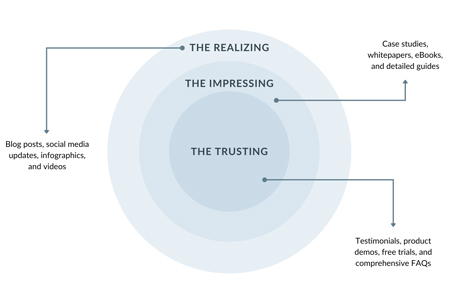
Supercharge Your Content Marketing ROI By Understanding The Three Buyer Psyches

 The IT services sector and product businesses are in an increasingly competitive market. While establishing engineering excellence is essential, it is also considered table stakes by buyers. The advent of AI has further reduced the entry barriers and made it harder to differentiate one's offerings. What can companies and their CEOs do to cut through the clutter?
The IT services sector and product businesses are in an increasingly competitive market. While establishing engineering excellence is essential, it is also considered table stakes by buyers. The advent of AI has further reduced the entry barriers and made it harder to differentiate one's offerings. What can companies and their CEOs do to cut through the clutter?
Content marketing remains a powerful tool to build credibility and capture customers’ minds and imaginations. Through thought leadership and original content, businesses can build trust and expand their reach. However, content mar- keting is a monolithic term encompassing many strategies and tactics, including articulating problem statements, pain points, and oppor- tunities, educating customers, creating demand, generating awareness, selling solutions, and more. The only way to cut through the clutter is to bring all these together under a single strategy and track them holistically.
Creating and tracking your Content as a Portfolio
Creating content is much like buying stocks. You can make an educated guess about buying a stock, but you cannot predict how well it performs in your portfolio. Similarly, you can create one piece of content based on your best estimation of how it will be received. But you would be sloppy to rely on one or only a few pieces of content.
Much like individual stocks in a stock portfolio, you need multiple pieces of content with different attributes and objectives in your portfolio. Some content pieces have a long shelf life, some have a shorter shelf life, some are only to increase awareness, and others act as proof points of what you offer, some create a need in the minds of customers where none exists, and yet others convince the buyer about why your solution is the best for their need, and so forth. You can calculate the ROI of your content portfolio-that too in aggregate-only after you have consistently invested in different pieces of content and allowed them to compound together over time.
How different content pieces with different objectives work as one
The best content strategy works in aggregate because buyers need to see that variety through the different stages of their buying journey. I’ve seen many CXOs insist on bottom-of-the-funnel, sales-driving content. That approach does not consider where their buyers are in their journey.
The following illustration shows how you can align your content with the three mindsets of the buyer. Many commentators call them the buying stages, but I prefer to think of them as the three mindframes of the buyer. To succeed, your marketing team must double down on all three, not just pick a few or do a superficial job of any of them. The portfolio only works if it is set up correctly; otherwise, it is bound to fail.
Content that Generates Awareness (“The Realizing”)
Humans are highly enterprising and adaptive-we always find workarounds, find shortcuts, and cobble up solutions. Call it survival instinct—we always find a way and “make do” with what we have-“efficiency be damned, we are getting the job done”! The first order of business for your marketing team is to shake your buyers out of their stupor and make them aware of their inefficient, expensive, time-consuming, inconvenient workflows with content like blog posts, social media updates, infographics, and videos. Make people realize they have a thorn in their side that they can’t stand.
 Content that Impresses One to Consider You (“The Impressing”)
Content that Impresses One to Consider You (“The Impressing”)
Now that you have gotten your buyers out of their comfort zone, impress them. As they look around for solutions, they should find your content that offers deeper insights, comparisons, approaches, methodologies, and beliefs. Case studies, white- papers, eBooks, and detailed guides are highly effective tools to impress buyers with your capabilities and methods. This is the place to highlight your unique value proposition, approach to solving the problem, and beliefs and values that will ensure the durability of your solution in the buyer’s environment.
Content that Helps Make a Decision (“The Trusting”)
Decision-making is the most stressful time and frame of mind for a buyer. No buyer would like to buy a piece of software only to learn there was some pesky environmental factor, miscommunication, or something in the fine print that limits their success. Testimonials, product demos, free trials, and FAQs help soothe frayed nerves and help them purchase confidently.
It is not enough to address only one or two of the buyer mindsets mentioned above. They all work in tandem and are interlinked. Buyers see your solution in totality and go up and down this journey multiple times. Any ROI calculation on content works in aggregate and like a portfolio. Just like you cannot time and second-guess the stock market , you cannot selectively choose the content you want to create and second-guess the buyer.
How to craft a content strategy for lasting impact
Most companies are in the so-called red ocean, with many players vying for buyers’ attention. Companies must communi- cate their differentiated value proposition. Technology and engineering are important, but buyers expect best-in-class technology from all vendors. Differentiation has shifted upward in the value chain towards custom solutions, use cases, and effective storytelling that connects with them. It is futile to look at individual content pieces and calculate their effectiveness in isolation. Leaders must look at the interplay between content pieces across the three states of mind of the buyer to gauge the effectiveness and ROI of their content strategy.
Author's Bio: "Shivesh Vishwanathan is the Founder and CEO of FocusFew Consulting (www.focusfew.com). FocusFew helps technology firms and businesses on the digital path define their products and services, develop a differentiated value proposition, and create an enduring and durable brand."
LinkedIn - https://www.linkedin.com/in/shivesh/

